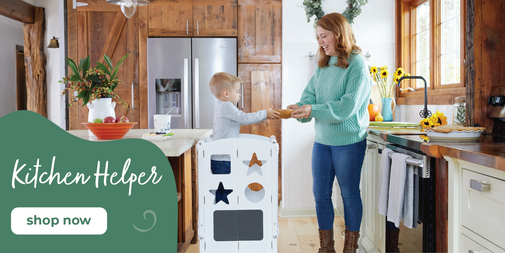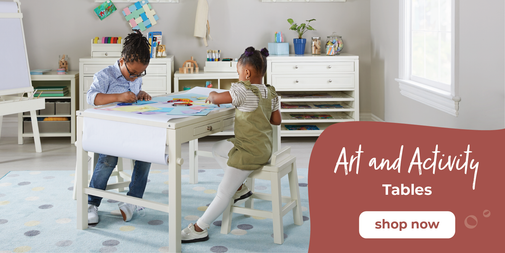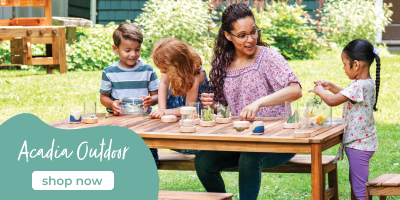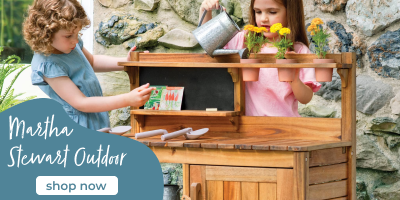Setting Up An Outdoor Atelier

What is an Atelier?
In Reggio-inspired schools, the atelier, or the art studio, sits at the heart of the school. It is a space designed to support the scaffolding of children’s fluency with multiple languages, create a context for looking deeply at what interests children, and allow educators to better understand children’s processes for thinking. Just as schools differ in their function and systems, ateliers come in all shapes and sizes. Some have a dedicated educator that facilitates the work in the space, called an atelierista. Others live directly in classrooms, similar to what traditional preschools might call an “art center”. What separates an atelier from an art center really comes down to intention. Ateliers put a focus on exploration, experimentation, and spontaneous creativity.

Why Have an Outdoor Atelier?
We know that spending time outdoors offers an abundance of benefits for young children, including: increased focus, higher self-regulation, and a boosted immune system. It can also be said that time outside offers children an alternative context for thinking and learning, as the environment is innately different than a classroom. Plus, there is the added benefit that when you’re outside, cleaning up a messy art experience usually just involves a hose!
3 Considerations for Setting Up an Outdoor Atelier

1. Space & Arrangement
Depending on your preferences, you may want to look for a space that offers protection from the elements, such as a covered deck or patio or even under a shady tree. This will allow for access to outdoor experiences during most weather.
It's important to offer enough space that children can move around comfortably. In a creative environment, children will naturally want to transport and transform materials, so offering a couple of surfaces for working will be helpful. These surfaces can of course be tables, but could also be trays or low platforms on the ground.
A water source near by is a huge plus! Not only will this make clean up a breeze, but water is a magical addition to any space. Pair water with loose parts or watercolors and pipettes. Of course a hose will work, but even a water cooler would do the job!

2. Materials
Of course we want some artistic materials in our outdoor atelier! Some of the most beloved materials are:
- Paint
- Paint sticks
- Watercolors (liquid and palettes)
- Markers
- Chalk pastels
- Washi tape
Again, consider your environment and whether or not these materials can be left out in your climate. You may consider arranging a basket with materials that can easily be transported outside

Don’t forget the clay! Utilizing clay outdoors is such a beautiful experience, free from the stress of mess. Clay is also a natural material, making it quite durable. Air dry clay works great with young children, but also consider a natural clay for a different experience. Pair clay with things like:
- Craft wire
- Beads or tiles
- Natural materials (sticks, pinecones, rocks, leaves, etc.)
- Golf tees
Various tools for creating. Consider:
- Paint brushes of different sizes
- Pipettes or droppers
- Corrugated cardboard
- Sponges
- Egg cartons
- Burlap or canvas
Outside of the traditional artistic materials, loose parts can be utilized in an atelier as yet another language. Loose parts are simply open-ended materials that children can use in a multitude of ways. Think:
- Corks
- Sea shells
- Colorful acrylic blocks
- Napkin rings
- Candle sticks
- Spools
- Containers
- Gems
- Buttons
Pair loose parts with acrylic mirrors and tabletop spot lights for added magic!

3. Organization & Aesthetic
A core pillar of the Reggio-Emilia Approach is the image of the child as a capable and curious citizen of the world, worthy of all the respect and consideration we offer adults. Within this image, we view children as trustworthy human beings who deserve access to beauty and can appreciate aesthetics. As adults, we curate and offer materials to children and take care to present them with intention. This can look like:
- Child accessible materials
- A space free from clutter
- Materials arranged by color or size
- Utilization of glass containers
- Hanging or potted plants
No matter where you decide to set up your outdoor atelier or what materials you have to use, the most important part is to step back and let children lead the way. Pablo Picasso said it best, “Every child is an artist”. All we have to do is allow space for their creativity to freely flow.




















